Some Pre-Pesach Messages, Changes in Deliveries:
- There will be no delivery over Chol Hamoed, Monday, April 10, and Wednesday, April 12.
- Deliveries scheduled for the Monday after Pesach will be moved to Tuesday, April 18. Wednesday deliveries will remain as usual.
Bi-weekly recipients:
Since we do not deliver over Chol Hamoed, bi-weekly delivery recipients will be facing a three-week gap. Therefore, if you wish to expand your regular boxes or make a special order for the holidays, please contact us as soon as possible to give advance notice.
Open Day at Chubeza:
In keeping with our twice-yearly tradition, we invite you for a Chol HaMoed “pilgrimage” to Chubeza to celebrate our Open Day.
The Pesach Open Day will take place on Thursday, April 13, the 17th of Nissan, between 1:00 PM -6:00 PM. For those of you who not yet haven’t experienced it, the Open Day gives us a chance to meet, tour the field, and nibble on vegetables and other delicacies. Children have their own tailor-made tours designed for little feet and curious minds, plus special arts and crafts and cooking activities and a vast space to run around and loosen up. (So can the adults…)
On Open Day, we also have a stand for vegetable sales, so you can replenish your vegetable supply.
The festivities take place in the fields outside the moshav. Driving instructions are on our website under “Contact Us.” Please make sure to check this out before heading our way.
Chag Sameach from all of us. We look forward to seeing you!
_______________________________
A glimpse of life at the Iza Pziza dairy:
Between Purim and Pesach, spring awakens in a beautiful blossoming of wild flowers in green and white and yellow…
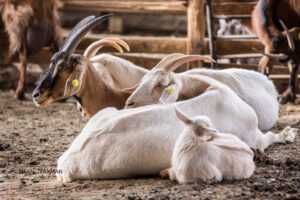 Our young kids, born during the whelping season, have by now matured from “kids” to “doelings” (female goats that have not reached maturity) and to bucklings” (immature male goats.) Once a female goat has reached maturity, she is called a “doe” and a mature male goat is called a “buck.” A full year will pass between the time a female kid becomes a doe who nurses her own newborn kids.
Our young kids, born during the whelping season, have by now matured from “kids” to “doelings” (female goats that have not reached maturity) and to bucklings” (immature male goats.) Once a female goat has reached maturity, she is called a “doe” and a mature male goat is called a “buck.” A full year will pass between the time a female kid becomes a doe who nurses her own newborn kids.
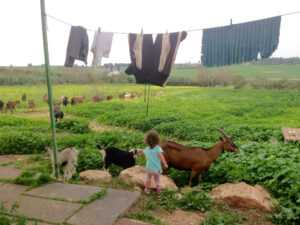 At our dairy, we take special care to allow the young kids to nurse from their mothers, which is why we do not milk the goats from the very beginning of gestation until the kids are approximately two months old. Only when they begin the process of weaning and start eating “adult” food do we return to milking the mothers.
At our dairy, we take special care to allow the young kids to nurse from their mothers, which is why we do not milk the goats from the very beginning of gestation until the kids are approximately two months old. Only when they begin the process of weaning and start eating “adult” food do we return to milking the mothers.
Of course, we take measures not to separate the kids and their mothers upon their birth, and the little ones are free to enter and exit the pen, graze in the pastures and nurse away to their heart’s (and belly’s) content.
____________________________________________
House of Card(oon)s!
Over the next few weeks you will be receiving cardoons, aka
artichoke thistle, cardone, cardoni, carduni, or cardi, or… not known at all. He’s simply not the most outgoing type, but rather an exclusive and remarkable vegetable known mostly to traditional cooks, Baladi and “old school” vegetable enthusiasts, and those of you searching for unusual products at the market.
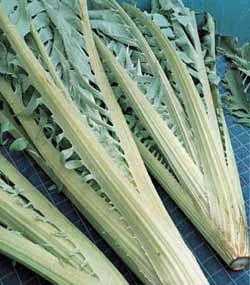
The cardoon, or wild artichoke, is actually a brother to the artichoke. Like any sibling, they are similar though different. Basically, their plants are rather similar, but the cardoon invests a lot of effort into its leaves and stems, making him taller than his brothers with larger, more erect leaves and a thicker spine. The cardoon does produce small thistly artichokes, but usually they’re tiny, more for decorative purposes, without much actual food content. In our field, at the end of the artichoke beds we planted a row of cardoon, and when they’re standing beside each other you can definitely notice the difference.
Those who already know me recognize that I learn a lot about life and parenting from our plants in the field. In this case too, the mother and father of the artichoke and cardoon, i.e., the farmers who cultivated them over the years, saw that different children in their bed boast different characteristics and tendencies. Instead of asking the cardoon, “Why can’t you just grow nice thistles like your brother, the artichoke?” (or the other way around), the farmers of old chose to cultivate the stronger virtues in each, and thus they were rewarded. Big time. The dinner table received a wider variety of foods, which are both tasty and a delight to lay eyes upon.
The cardoon has been eaten wild since ancient times, probably cultivated from the Middle Ages. It is joyfully eaten in Greece, Italy, France, South Africa and Spain. The edible part is the chubby spine in the center of the leaves, which was eaten raw, cooked, baked, steamed or fried from the time of the Roman Empire. A cardoon extraction was used to coagulate milk for cheese making. This vegetable was so greatly admired that it inspired Northern European farmers pining for their local cuisine to develop a substitute – the Swiss chard… and this is how it happened: The Romans took along their culinary habits and recipes everywhere they went. But the cardoon, like his brother the artichoke, cannot grow in the frigid North, being very sensitive to cold weather. Thus, Northern Europe needed a substitute, which became Swiss chard. It, too, hosts a thick and juicy stalk and can be eaten raw, steamed, fried or baked. The flavor, however, is not at all the same. Cardoon tastes like… well, artichoke, while the chard stalk tastes altogether different. But as we all know, we start eating with our eyes, and when longing overcomes us, the substitutes can be convincing. This is how Swiss chard received its name “chard,” resembling the “cardoon”.
Cardoon harvest is similar to that of celery. We cut the stems at their base. As it is a huge plant, we need to trim the leaves – which are not edible – in order to fit them in your boxes, leaving the long, juicy stems. Sometimes the stems themselves are very long, requiring us to slice them in half, which is why some of you will receive two relatively short bundles, while others will get one long bundle.
Cooking the cardoon requires some effort, for the leaves must be removed from the stems (they can be used in some recipes), and peeled to remove the bitter fibrous skin. You can use a sharp knife or peeler, but don’t over-peel. Remove only a thin layer so you still have what to enjoy when you’re done (but don’t abstain from peeling. The results can be quite bitter, and I speak from experience…).
Watch a demonstration of this process here:
As you peel, place the peeled cardoons in water with lemon juice to prevent discoloration. This is what clean cardoons look like:
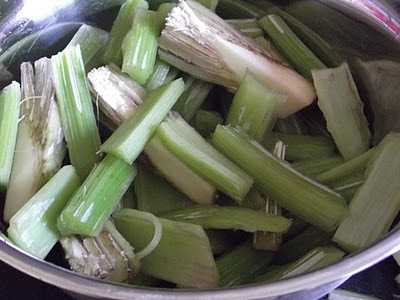
After cleaning them, cook the cardoons in boiling water for fifteen minutes and drain, till they receive this shade:
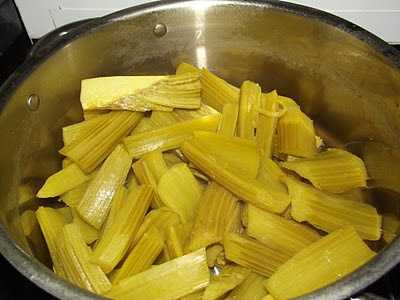
They’re all yours now – cook them with tomatoes, chickpeas, fava beans or Jerusalem artichoke. They’re excellent with lemon. Cardoon can be added to chicken or meatballs, even fish. You can stuff it (the stems can be used as a little stuffing boat), fry as you would a schnitzel, make cold salads, etc., etc. They can also be frozen for future use.
Enjoy a healthy, spring week,
Alon, Bat Ami, Dror, Yochai and the Chubeza team
________________________________
Cardoon recipes:
Honeyed cardoons with pine nuts and thyme (scroll down)
Several cardoon reipes – from Marquita farm
More cardoon reipes from Ocean Mist farm
__________________________________
WHAT’S IN THIS WEEK’S BOXES?
Monday: Parsley/coriander, New Zealand spinach/Swiss chard/broccoli leaves/kale, lettuce/ arugula/mizuna, cucumbers, kohlrabi/beets, cabbage, tomatoes, radishes/celeriac, leeks/ green garlic/fresh onions, cherry tomatoes/fava beans, carrots.
Large box, in addition: Cauliflower/cardoon, potatoes, garden peas/snow peas.
Wednesday: Parsley/coriander, lettuce/mizuna, cucumbers, kohlrabi/cauliflower, cabbage, tomatoes, cardoon/celeriac/green garlic, leek/fresh onions, cherry tomatoes/fava beans, carrots/zucchini, garden peas/snow peas.
Large box, in addition: New Zealand spinach/Swiss chard/broccoli leaves/kale, beets, potatoes.
And there’s more! You can add to your basket a wide, delectable range of additional products from fine small producers: flour, fruits, sprouts, honey, dates, almonds, garbanzo beans, crackers, probiotic foods, dried fruits and leathers, olive oil, bakery products, apple juice, cider and jams, dates silan and healthy snacks and goat dairy too! You can learn more about each producer on the Chubeza website. On our order system there’s a detailed listing of the products and their cost, you can make an order online now!
